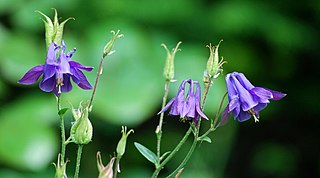
Aquilegia is a genus of about 130 species of perennial plants that are found in meadows, woodlands, and at higher elevations throughout the Northern Hemisphere, known for the spurred petals of their flowers.
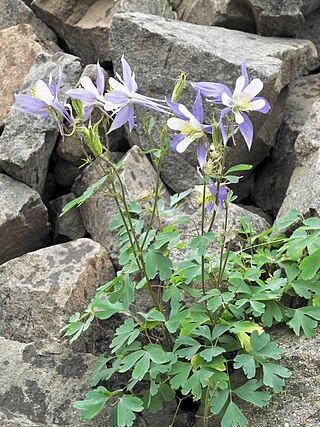
Aquilegia coerulea, the Colorado columbine, Rocky Mountain columbine, or blue columbine, is a species of flowering plant in the buttercup family Ranunculaceae, native to the Rocky Mountains and some of the surrounding states of the western United States. It is the state flower of Colorado. The Latin specific name coerulea means "sky blue".

Aquilegia grata is a perennial species of flowering plant in the family Ranunculaceae, endemic to the northwestern Balkans.
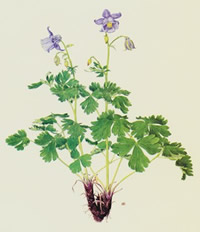
Aquilegia nuragica, commonly called Nuragica columbine, is a perennial flowering plant in the family Ranunculaceae. It is endemic to Italy, in a single canyon in the Supramonte mountain range on the island of Sardinia.

Aquilegia chrysantha, the golden columbine, is a perennial herbaceous flowering plant native to the southwestern United States and northwestern Mexico.

Aquilegia saximontana, the Rocky Mountain columbine, alpine dwarf columbine, dwarf blue columbine, or alpine columbine, is a perennial plant that comes from the buttercup family, Ranunculaceae.
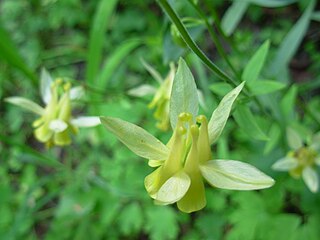
Aquilegia flavescens, the yellow columbine, is a perennial species of flowering plant in the family Ranunculaceae, native to the Rocky Mountains of the United States and Canada.
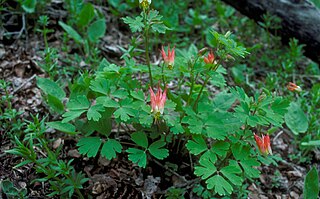
Aquilegia elegantula, the western red columbine, is a perennial species of flowering plant in the family Ranunculaceae, native to the Southwestern United States and northern Mexico.
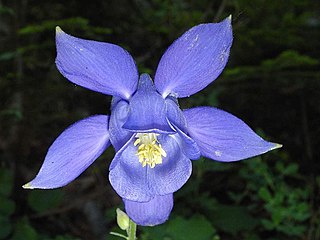
Aquilegia bertolonii, common name Bertoloni columbine or Bertoloni's columbine, is a perennial species of flowering plant in the family Ranunculaceae, native to Italy, southern France, and Slovenia.

Aquilegia pyrenaica, common name Pyrenean columbine, is a species of flowering plant in the family Ranunculaceae. It is endemic to the Pyrenees where it grows on grassland and in rocky places. It was first described in 1805 by Augustin Pyramus de Candolle who gave it the name Aquilegia pyrenaica.

Aquilegia longissima, the long-spur columbine or long-spurred columbine, is a rare perennial flowering plant in the family Ranunculaceae that is native to northern Mexico, Texas, and Arizona.

Aquilegia atrata, the dark columbine, is a perennial species of flowering plant in the family Ranunculaceae, native to the Alps and Apennine Mountains.

Aquilegia olympica is a perennial flowering plant in the family Ranunculaceae, native to Turkey, Iran, and the Caucasus.

Aquilegia ecalcarata, the spurless columbine or false columbine, is a perennial species of flowering plant in the family Ranunculaceae, native to central China.

Aquilegia sibirica, the Siberian columbine, is a species of flowering plant in the family Ranunculaceae native to the north-central Asian regions of Siberia, northern Mongolia, Kazakhstan, and Xinjiang. A hardy perennial plant, it prefers temperate environments. The Siberian columbine can be between 1 foot (0.30 m) and 2 feet (0.61 m) tall with flowers that are lilac-blue and white in color.

Aquilegia champagnatii is a perennial species of flowering plant in the family Ranunculaceae, native to Italy.

Aquilegia einseleana, or Einsele's columbine, is a perennial species of plant in the family Ranunculaceae, native to the eastern Alps.

Aquilegia glandulosa, the Altai columbine or Siberian columbine, is a perennial species of flowering plant in the family Ranunculaceae, native to northern and central Asia.
Aquilegia incurvata, or the Qinling columbine (秦岭耧斗菜), is a perennial species of flowering plant in the family Ranunculaceae, endemic to the Qinling mountain range in China.
Aquilegia litardierei is a perennial species of plant in the family Ranunculaceae, endemic to Corsica.





















